I never thought I would get to see a real Mayan Ruin, but that was on our itinerary for our visit to Belize on the last cruise we took before the pandemic became a worldwide concern. The site was only discovered by archeologists in the early 1960s, and excavations started in 1964. A pretty thorough description of the site’s history can be found on Wikipedia here. The opening image is a side view of the construction of the Temple of the Sun God. It is also known as the Temple of the Masonry Altars. The height of the temple is 52 feet (16 m) and is the largest construction on the 3 sq mi (8 sq km) site.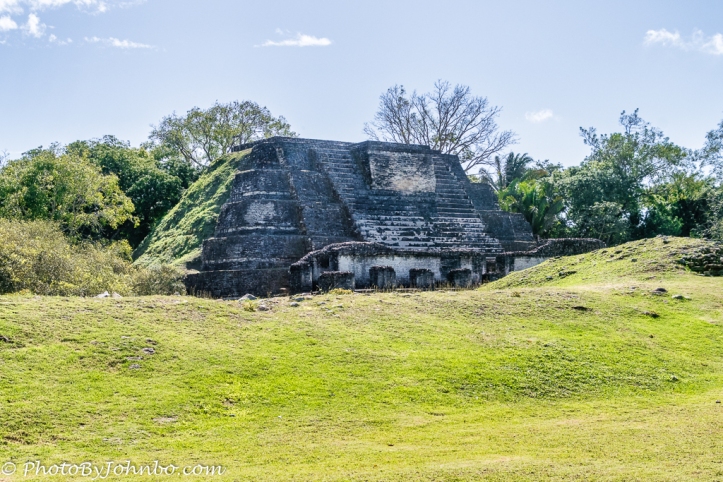 Our guided tour started with the area known as Plaza A which is dominated by the Temple of the Green Tomb. Deep inside is a tomb of a priest-king who was laid to rest there around 600 A.D. The site that has been restored is the central core of a city estimated to be around 8-10,000 population. The earliest excavations in the site are older than the two temples and appear to be dated around 900 B.C, yet another article on the Internet noted the first settlements of the Mayan city were only as far back as 250 B.C. I take from that discrepancy that archeology is an inexact science.
Our guided tour started with the area known as Plaza A which is dominated by the Temple of the Green Tomb. Deep inside is a tomb of a priest-king who was laid to rest there around 600 A.D. The site that has been restored is the central core of a city estimated to be around 8-10,000 population. The earliest excavations in the site are older than the two temples and appear to be dated around 900 B.C, yet another article on the Internet noted the first settlements of the Mayan city were only as far back as 250 B.C. I take from that discrepancy that archeology is an inexact science.
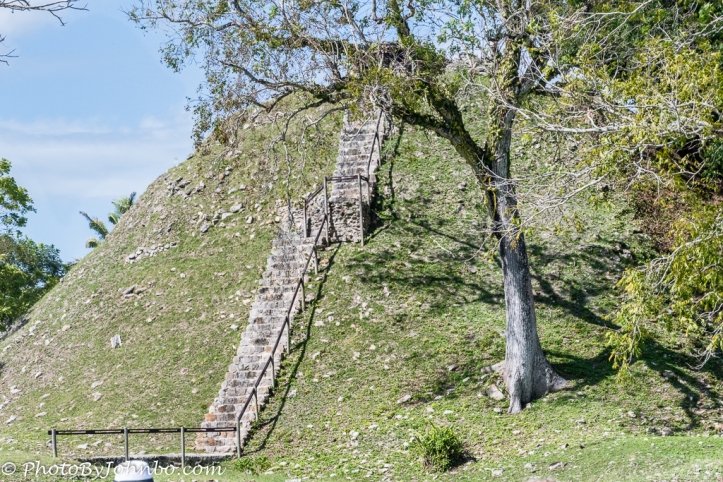 Visitors can climb these steep steps to the top of the Temple of the Green Tomb. All of the burial chambers contained jade ornaments and statues that are the source of the temple’s name.
Visitors can climb these steep steps to the top of the Temple of the Green Tomb. All of the burial chambers contained jade ornaments and statues that are the source of the temple’s name.
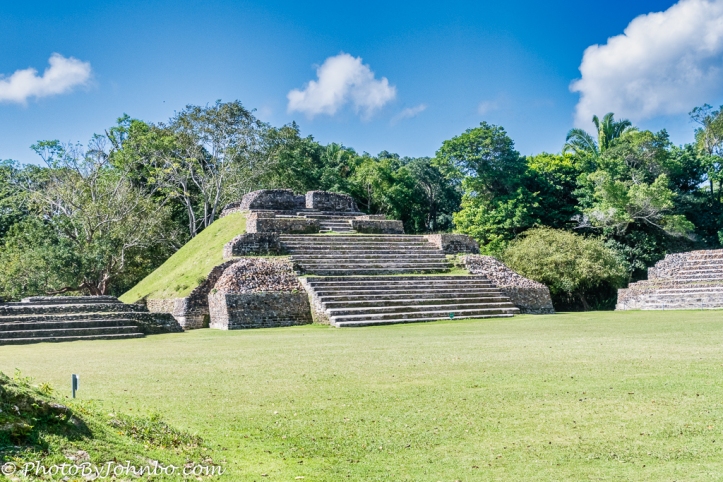 We spent most of our time in Plaza B at the Temple of the Masonry Altars. In 1968, the structure was excavated. It contained several tombs, many of which had been destroyed or looted, however, one tomb discovered was relatively untouched. Along with the deceased, there were numerous jade sculptures including a carving of the head of the Maya sun god, Kinich Ahau. That sculpture is the largest piece of jade ever recovered from a Mayan site. The 6-inch (152 mm) tall artifact is depicted on Belizean banknotes. That tomb is located under the large stone that’s at the left of the center stone at the top of the large staircase in the photo above.
We spent most of our time in Plaza B at the Temple of the Masonry Altars. In 1968, the structure was excavated. It contained several tombs, many of which had been destroyed or looted, however, one tomb discovered was relatively untouched. Along with the deceased, there were numerous jade sculptures including a carving of the head of the Maya sun god, Kinich Ahau. That sculpture is the largest piece of jade ever recovered from a Mayan site. The 6-inch (152 mm) tall artifact is depicted on Belizean banknotes. That tomb is located under the large stone that’s at the left of the center stone at the top of the large staircase in the photo above.
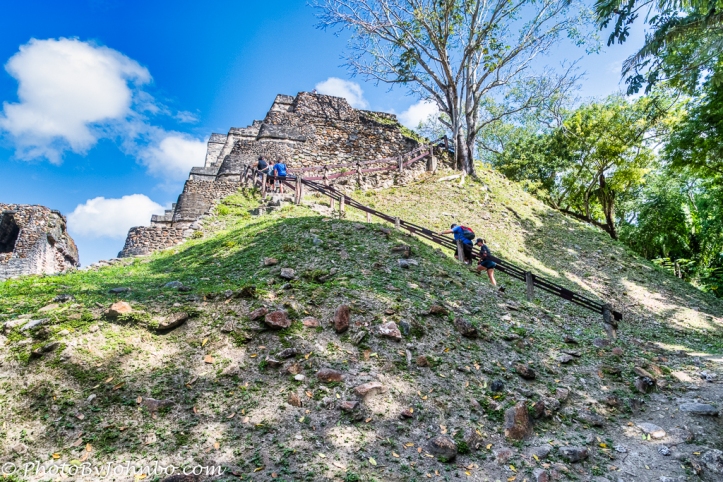 My wife and I are no youngsters, so it was with some trepidation that our party of four decided to climb the many steps to the top of the structure. I set the tone by saying, “I didn’t come all the way to Belize to regret that I didn’t climb the temple once we get home again.” With that, the decision was made. If you decide to make that same decision, please take your time. It is a strenuous climb for those of us who have reached a certain age, (not as young as we used to be… just sayin’). We took our time on the climb and were rewarded with commanding views of the site.
My wife and I are no youngsters, so it was with some trepidation that our party of four decided to climb the many steps to the top of the structure. I set the tone by saying, “I didn’t come all the way to Belize to regret that I didn’t climb the temple once we get home again.” With that, the decision was made. If you decide to make that same decision, please take your time. It is a strenuous climb for those of us who have reached a certain age, (not as young as we used to be… just sayin’). We took our time on the climb and were rewarded with commanding views of the site.
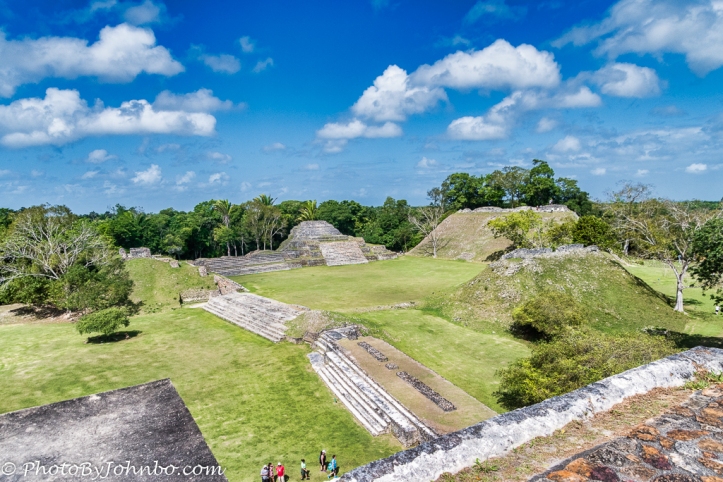 This view was captured from the top of the Temple of Masonry Altars and features a bird’s eye view of Plaza A and the Temple of the Green Tomb. We would learn from the knowledgeable tour guide that there was no evidence of human sacrifice at this site. It appears that the sacrificial objects were jade carvings. The site features a large information center with more history and concluded with a walk through a small section of shops that lined the walkway back to the parking area where we boarded our bus to travel to our next stop on the tour. The site is located about 30 miles (50 km) north of Belize City. During the COVID-19 pandemic, I don’t know whether the site is open or not. Please confirm the site’s current status before you travel.
This view was captured from the top of the Temple of Masonry Altars and features a bird’s eye view of Plaza A and the Temple of the Green Tomb. We would learn from the knowledgeable tour guide that there was no evidence of human sacrifice at this site. It appears that the sacrificial objects were jade carvings. The site features a large information center with more history and concluded with a walk through a small section of shops that lined the walkway back to the parking area where we boarded our bus to travel to our next stop on the tour. The site is located about 30 miles (50 km) north of Belize City. During the COVID-19 pandemic, I don’t know whether the site is open or not. Please confirm the site’s current status before you travel.
The gallery of images below features my favorite captures from our morning spent at Altun Ha. As I’ve noted many times before, in most browsers you can click on an image to enlarge it and to scroll through the gallery.
John Steiner













Those look amazing. Think how oldthey are and the history that is there.
Indeed. One of the things I took away from the tour is that the civilization was a lot more widespread in the region than I realized.
Amazing! Good for you for making it to the top. 😊
Thanks. It was worth the effort.
Neat photos, fun fact, the national beer brand, Belikin, features the Temple of the Green Tomb on its bottle.
Thanks for stopping by and taking the time to comment!